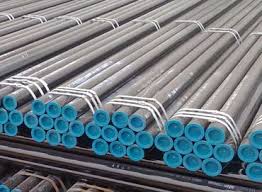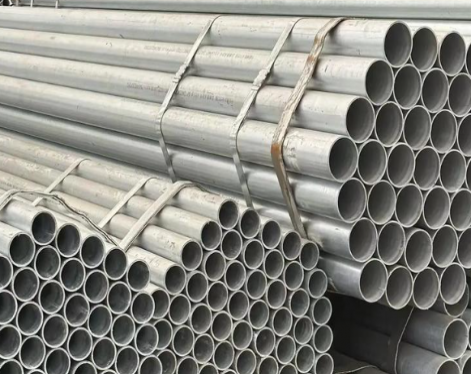What is an expansion joint?
The expanded connection is made of malleable cast iron or ductile iron as the main material, and consists of a lined pipe body (bushing), nuts or bolts, threaded rings or expanded pressure flanges, and sealing rubber rings. It adopts fastening nuts or pressure flanges. In this way, the pipe compresses the sealing ring, so that the inner surface of the pipe and the sealing ring on the lining pipe body are connected to the metal pipe fittings to form a diagonal sealing connection.
Advantages of carbon steel seamless pipe(cs seamless pipe) expansion connection
1. Mechanical properties
The pipe port of the flared interface expands into a bell mouth shape. The size of the inner liner and the inner diameter of the pipe fitting are consistent with the nominal inner diameter of the pipe. There is no diameter reduction at the connection, which does not affect the flow of the carbon steel seamless pipe, and the local head loss of the pipe is small.

2. Connection sealing characteristics
The flared interface is sealed by crimping the beveled side internal seal, which avoids the fluid being released from the end face of the pipe, thereby ensuring that there will be no end-face corrosion that may cause the "tearing cloth effect" that causes damage to the multi-layer structure of carbon steel seamless pipes.
3. Installation performance
(1) The expanded connection interface is convenient, quick and easy to install and operate. The connection can be disassembled and assembled repeatedly, and it is also convenient for long insertion construction.
(2) The expanded connection interface can transport the medium after the connection is completed. There is no need to wait for the fixed line or cooling. It is extremely convenient for carbon steel seamless pipes that need to be decorated, modified, and updated.
(3) The expanded interface connection has no special requirements for the installation and working environment.
(4) The flared interface connection expands the pipe into a bell mouth, causing the steel strip of the pipe to be permanently deformed. Then the tightening nut or flange is used to shrink the pipe to reach the inner surface of the pipe and the lining pipe. The sealing rubber rings on the body are arranged in oblique side seals, with reliable installation performance and excellent pull-out resistance. There is no need to consider anti-slip measures for pipe interfaces, which reduce the difficulty of construction and additional costs.
(5) The flared connection adopts a nut or bolt fastening method, which is easy to install and operate.
4. Pressure-bearing mechanical properties
The flared interface pipe fittings are made of metal and have the same bearing capacity as the pipe. The pipe connection does not reduce the diameter or pressure, and the pressure is lower than that of the pipe.
Although the flared connection has the above advantages, it also has the following disadvantages:
1. There is limited position: Since the flare connection requires one part to be inserted into another part, the position of the connected parts is limited.
2. Poor sealing: Because the flared connection only achieves the purpose of connection by the parts interlocking with each other, there are certain defects in sealing and leakage and other problems are prone to occur.
3. Insufficient strength: Compared with other connection methods, flared connections have certain limitations in strength. Especially when faced with larger stresses and loads, problems such as fatigue fracture may occur.
The expanded connection is made of malleable cast iron or ductile iron as the main material, and consists of a lined pipe body (bushing), nuts or bolts, threaded rings or expanded pressure flanges, and sealing rubber rings. It adopts fastening nuts or pressure flanges. In this way, the pipe compresses the sealing ring, so that the inner surface of the pipe and the sealing ring on the lining pipe body are connected to the metal pipe fittings to form a diagonal sealing connection.
Advantages of carbon steel seamless pipe(cs seamless pipe) expansion connection
1. Mechanical properties
The pipe port of the flared interface expands into a bell mouth shape. The size of the inner liner and the inner diameter of the pipe fitting are consistent with the nominal inner diameter of the pipe. There is no diameter reduction at the connection, which does not affect the flow of the carbon steel seamless pipe, and the local head loss of the pipe is small.

2. Connection sealing characteristics
The flared interface is sealed by crimping the beveled side internal seal, which avoids the fluid being released from the end face of the pipe, thereby ensuring that there will be no end-face corrosion that may cause the "tearing cloth effect" that causes damage to the multi-layer structure of carbon steel seamless pipes.
3. Installation performance
(1) The expanded connection interface is convenient, quick and easy to install and operate. The connection can be disassembled and assembled repeatedly, and it is also convenient for long insertion construction.
(2) The expanded connection interface can transport the medium after the connection is completed. There is no need to wait for the fixed line or cooling. It is extremely convenient for carbon steel seamless pipes that need to be decorated, modified, and updated.
(3) The expanded interface connection has no special requirements for the installation and working environment.
(4) The flared interface connection expands the pipe into a bell mouth, causing the steel strip of the pipe to be permanently deformed. Then the tightening nut or flange is used to shrink the pipe to reach the inner surface of the pipe and the lining pipe. The sealing rubber rings on the body are arranged in oblique side seals, with reliable installation performance and excellent pull-out resistance. There is no need to consider anti-slip measures for pipe interfaces, which reduce the difficulty of construction and additional costs.
(5) The flared connection adopts a nut or bolt fastening method, which is easy to install and operate.
4. Pressure-bearing mechanical properties
The flared interface pipe fittings are made of metal and have the same bearing capacity as the pipe. The pipe connection does not reduce the diameter or pressure, and the pressure is lower than that of the pipe.
Although the flared connection has the above advantages, it also has the following disadvantages:
1. There is limited position: Since the flare connection requires one part to be inserted into another part, the position of the connected parts is limited.
2. Poor sealing: Because the flared connection only achieves the purpose of connection by the parts interlocking with each other, there are certain defects in sealing and leakage and other problems are prone to occur.
3. Insufficient strength: Compared with other connection methods, flared connections have certain limitations in strength. Especially when faced with larger stresses and loads, problems such as fatigue fracture may occur.









